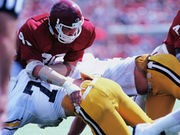

Concussion-prevention rules for college football players may have led to an unintended consequence — an increase in knee, thigh and ankle injuries among players, new research suggests.
“Of course concussions sustained in football can be devastating,” said study author Dr. Robert Westermann, chief resident at the University of Iowa in Iowa City. “But so can lower extremity injuries, which are the leading cause of disability among NFL [National Football League] retirees. So, it’s important to protect the whole athlete.
“But our work,” he added, “suggests that a change in the pattern of play following the new push to reduce head-to-head contact among players may be causing an increase in injuries lower down the body.”
Westermann emphasized that the study was only designed to find an association between the change in football rules and an increase in leg, joint and foot injuries. It did not prove cause-and-effect.
Westermann and his colleagues presented their findings Saturday at a meeting of the American Orthopaedic Society for Sports Medicine, in Orlando, Fla.
At the time it adopted its latest concussion-related guidelines, National College Athletic Association (NCAA) data showed that college players had experienced more than 41,000 injuries overall between 2004 and 2009. Concussions — also known as mild traumatic brain injuries — accounted for more than 7 percent of that total, according to the NCAA.
With that in mind, the NCAA adopted several new contact rules for football in 2008. They included banning the so-called “horse-collar tackle,” in which a player is pulled down by his collar or shoulder pad, and protecting players from the two-on-one “chop block” maneuver. The revised rules also called for a focus on getting rid of all blows to the head, and all hits on defenseless players, according to the NCAA.
The new study included information collected by athletic trainers and physicians between 2009 and 2014 as part of the NCAA Injury Surveillance System.
Lower extremity injuries included those affecting the leg, knee, ankle and foot, the study authors said. Concussion risk information was also gathered.
Roughly 2,400 leg, joint or foot injuries serious enough to cause a time-out in play occurred during the study time frame. About a third involved injuries to the knee, while slightly less than that involved ankle trouble. Nearly 60 percent were the result of player-to-player contact, the researchers reported.
Concussion risk remained relatively “stable” over the study period, the research revealed. But, leg, joint and foot injuries rose from about 9 per 1,000 “athletic exposures” during the 2009-10 seasons (before the new rules were implemented) to nearly 13 per 1,000 by the 2013-14 season, the study showed.
Why? The investigators suggest that the rise may have been prompted by the effort to avoid head-to-head contact, causing players to target other players lower on the body.
Westermann stressed that the study doesn’t prove causation. But, he added, “it does seem that lower extremity injuries have gone up since we made the rules to prevent head injuries.
“Now I can’t say what should be done about this,” he continued. “I’m not part of the NCAA rules committee. But I do believe that when you make a big change like this you need to study the effects and ramifications it can have on athletes. So that’s what we’ve done.”
Dr. Katherine Coyner is an assistant professor in the department of orthopaedic surgery at UT Southwestern Medical Center in Dallas. She said Westermann’s research team may be on to something.
It’s hard to establish a direct correlation from one study. And there are multiple variables that can come into play, she said.
“However the idea that rule changes may have affected the nature of the injuries does make sense conceptually,” Coyner added.
But does a lower concussion risk inevitably mean raising the risk for other types of injuries? Coyner said no one really knows yet.
“The truth is that football is a contact sport, more than any other,” she said. “That’s part of the game, and as a result we always see injuries. So it may be that we have to do a kind of a risk-benefit analysis.
“Certainly arthritis risk due to lower extremity injury is not desirable,” she added. “But neither are the lifelong consequences of traumatic brain injury. It may mean placing more of a focus on which one is more important. Only time will tell.”
Findings presented at medical meetings are generally viewed as preliminary until published in a peer-reviewed journal.
More information
There’s more on concussion rules at the U.S. National Collegiate Athletic Association.
Source: HealthDay
Copyright © 2025 HealthDay. All rights reserved.

Leave a Reply